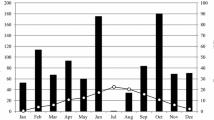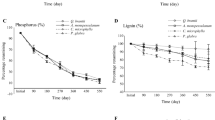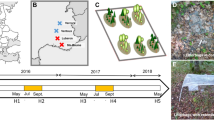Abstract
Aims
Drought-induced forest die-off and subsequent species replacement may modify environmental conditions and eventually affect litter decomposition. We aimed to disentangle the effects of tree species and die-off state on litter decomposition in a mixed forest where Pinus sylvestris populations experiencing severe drought-induced die-off are being replaced by Quercus ilex.
Methods
Litter bags with leaves and fine roots from both species were placed under canopies representing three habitats of the die-off and replacement process (healthy and dead P. sylvestris and healthy Q. ilex). Mass was assessed over 3 years.
Results
Species-specific chemistry of litter (C:N ratio) had a direct effect on mass loss, but also indirect effects, attributed to the decomposer microbial community associated with a given habitat-species. In their respective original habitats, oak leaves decomposed 44 % faster than pine needles, whereas oak roots decomposed 46 % slower than pine roots.
Conclusions
Forest die-off and species replacement affected litter decomposition. This effect can have great implications in forest functioning, particularly if drought-induced die-off worsens in the next decades, according with the trend observed in the studied system.




Similar content being viewed by others
References
Allen CD, Macalady AK, Chenchouni H et al (2010) A global overview of drought and heat-induced tree mortality reveals emerging climate change risks for forests. For Ecol Manag 259:660–684
Aponte C, García LV, Marañón T (2012) Tree species effect on litter decomposition and nutrient release in Mediterranean oak forests changes over time. Ecosystems 15:1204–1218
Austin AT, Vivanco L (2006) Plant litter decomposition in a semi-arid ecosystem controlled by photodegradation. Nature 442:555–558
Austin AT, Vivanco L, González-Arzac A, Pérez LI (2014) There’s no place like home? An exploration of the mechanisms behind plant litter-decomposer affinity in terrestrial ecosystems. New Phytol 204:207–214
Ayres E, Steltzer H, Berg S, Wall DH (2009a) Soil biota accelerate decomposition in high-elevation forests by specializing in the breakdown of litter produced by the plant species above them. J Ecol 97:901–912
Ayres E, Steltzer H, Simmons BL et al (2009b) Home-field advantage accelerates leaf litter decomposition in forests. Soil Biol Biochem 41:606–610
Ball BA, Bradford MA, Coleman DC, Hunter MD (2009) Linkages between below and aboveground communities: Decomposer responses to simulated tree species loss are largely additive. Soil Biol Biochem 41:1155–1163
Barba J, Curiel Yuste J, Martínez-Vilalta J, Lloret F (2013) Drought-induced tree species replacement is reflected in the spatial variability of soil respiration in a mixed Mediterranean forest. For Ecol Manag 306:79–87
Bardgett RD, Manning P, Morriën E, De Vries FT (2013) Hierarchical responses of plant-soil interactions to climate change: consequences for the global carbon cycle. J Ecol 101:334–343
Bates D, Maechler M, Bolker D, Walker S (2014) lme4: linear mixed-effects models using Eigen and S4
Berg B (2000) Litter decomposition and organic matter turnover in northern forest soils. For Ecol Manag 133:13–22
Berg B, McClaugherty C (2008) Plant litter: decomposition, humus formation, carbon sequestration. Springer-Verlag
Bigler C, Bräker OU, Bugmann H et al (2006) Drought as an inciting mortality factor in scots pine stands of the Valais, Switzerland. Ecosystems 9:330–343
Binkley D, Giardina C (1998) Why do tree species affect soils? The warp and woof of tree-soil interactions. Biogeochemistry 42:89–106
Bird JA, Torn MS (2006) Fine roots vs. needles: a comparison of 13C and 15N dynamics in a ponderosa pine forest soil. Biogeochemistry 79:361–382
Bonanomi G, Incerti G, Antignani V et al (2010) Decomposition and nutrient dynamics in mixed litter of Mediterranean species. Plant Soil 331:481–496
Briffa KR, van der Schrier G, Jones PD (2009) Wet and dry summers in europe since 1750: evidence of increasing drought. Int J Climatol 29:1894–1905
Canadell JG, Le Quéré C, Raupach MR et al (2007) Contributions to accelerating atmospheric CO2 growth from economic activity, carbon intensity, and efficiency of natural sinks. Proc Natl Acad Sci U S A 104:18866–18870
Cao MK, Woodward FI (1998) Dynamic responses of terrestrial ecosystem carbon cycling to global climate change. Nature 393:249–252
Carnicer J, Coll M, Ninyerola M et al (2011) Widespread crown condition decline, food web disruption, and amplified tree mortality with increased climate change-type drought. Proc Natl Acad Sci U S A 108:1474–1478
Carnicer J, Coll M, Pons X et al (2014) Large-scale recruitment limitation in Mediterranean pines : the role of Quercus ilex and forest successional advance as key regional drivers. Glob Ecol Biogeogr 23:371–384
Clemmensen KE, Bahr A, Ovaskainen O et al (2013) Roots and associated fungi drive long-term carbon sequestration in boreal forest. Science 339:1615–1618
Cornwell WK, Cornelissen JHC, Amatangelo K et al (2008) Plant species traits are the predominant control on litter decomposition rates within biomes worldwide. Ecol Lett 11:1065–1071
Cotrufo MF, Del Galdo I, Piermatteo D (2009) Litter decomposition: concepts, methods and future perspectives. In: Kutsch WL, Bahn M, Heinemeyer A (eds) Soil carbon dynamics. An integrated methodology. Cambridge University Press, New York, pp 76–90
Cotrufo MF, Wallenstein MD, Boot CM et al (2013) The Microbial Efficiency-Matrix Stabilization (MEMS) framework integrates plant litter decomposition with soil organic matter stabilization: do labile plant inputs form stable soil organic matter? Glob Chang Biol 19:988–995
Couteaux MM, Bottner P, Berg B (1995) Litter decomposition climate and litter quality. Trends Ecol Evol 10:63–66
Curiel Yuste J, Peñuelas J, Estiarte M et al (2011) Drought-resistant fungi control soil organic matter decomposition and its response to temperature. Glob Chang Biol 17:1475–1486
Curiel Yuste J, Barba J, Fernandez-Gonzalez AJ et al (2012) Changes in soil bacterial community triggered by drought-induced gap succession preceded changes in soil C stocks and quality. Ecol Evol 2:3016–3031
Davidson EA, Janssens IA (2006) Temperature sensitivity of soil carbon decomposition and feedbacks to climate change. Nature 440:165–173
Della-Marta PM, Haylock MR, Luterbacher J, Wanner H (2007) Doubled length of western European summer heat waves since 1880
Díaz-Pinés E, Schindlbacher A, Godino M et al (2014) Effects of tree species composition on the CO2 and N2O efflux of a Mediterranean mountain forest soil. Plant Soil 384:243–257
Flores-Rentería D, Curiel Yuste J, Rincón A et al (2015) Habitat fragmentation can modulate drought effects on the plant-soil-microbial system in Mediterranean Holm oak (Quercus ilex) forests. Microb Ecol 69:798–812
Freschet GT, Aerts R, Cornelissen JHC (2012) Multiple mechanisms for trait effects on litter decomposition: moving beyond home-field advantage with a new hypothesis. J Ecol 100:619–630
Freschet GT, Cornwell WK, Wardle DA et al (2013) Linking litter decomposition of above- and below-ground organs to plant-soil feedbacks worldwide. J Ecol 101:943–952
Gallardo A, Merino J (1993) Leaf decomposition in two Mediterranean ecosystems of southwest Spain: influence of substrate quality. Ecology 74:152–161
Gholz HL, Wedin DA, Smitherman SM et al (2000) Long-term dynamics of pine and hardwood litter in contrasting environments: toward a global model of decomposition. Glob Chang Biol 6:751–765
Giorgi F, Lionello P (2008) Climate change projections for the Mediterranean region. Glob Planet Chang 63:90–104
Grayston SJ, Prescott CE (2005) Microbial communities in forest floors under four tree species in coastal British Columbia. Soil Biol Biochem 37:1157–1167
Hereş AM, Martínez-Vilalta J, Claramunt López B (2012) Growth patterns in relation to drought-induced mortality at two Scots pine (Pinus sylvestris L.) sites in NE Iberian Peninsula. Trees 26:621–630
Hereter A, Sánchez JR (1999) Experimental areas of Prades and Montseny. In: Rodà F, Retana J, Gracia CA, Bellot J (eds) Ecology of Mediterranean evergreen oak forests. Springer, Berlin, pp 15–27
Jensen KD, Beier C, Michelsen A, Emmett BA (2003) Effects of experimental drought on microbial processes in two temperate heathlands at contrasting water conditions. Appl Soil Ecol 24:165–176
Kattge J, Díaz S, Lavorel S et al (2011) TRY - a global database of plant traits. Glob Chang Biol 17:2905–2935
Keiser AD, Keiser DA, Strickland MS, Bradford MA (2014) Disentangling the mechanisms underlying functional differences among decomposer communities. J Ecol 102:603–609
Killham K (1994) The soil biota. In: Killham K (ed) Soil ecology. Cambridge University Press, p 196
Lenoir J, Gégout JC, Dupouey JL et al (2010) Forest plant community changes during 1989–2007 in response to climate warming in the Jura Mountains (France and Switzerland). J Veg Sci 21:949–964
Lloret F, Siscart D, Dalmases C (2004) Canopy recovery after drought dieback in holm-oak Mediterranean forests of Catalonia (NE Spain). Glob Chang Biol 10:2092–2099
Lloret F, Escudero A, Iriondo JM et al (2012) Extreme climatic events and vegetation: the role of stabilizing processes. Glob Chang Biol 18:797–805
Mariotti A (2010) Recent changes in the Mediterranean water cycle: a pathway toward long-term regional hydroclimatic change? J Clim 23:1513–1525
Martínez-Vilalta J, Piñol J (2002) Drought-induced mortality and hydraulic architecture in pine populations of the NE Iberian Peninsula. For Ecol Manag 161:247–256
Mclaren JR, Turkington R (2010) Plant functional group identity differentially affects leaf and root decomposition. Glob Chang Biol 16:3075–3084
Mediavilla S, González-Zurdo P, García-Ciudad A, Escudero A (2011) Morphological and chemical leaf composition of Mediterranean evergreen tree species according to leaf age. Trees Struct Funct 25:669–677
Melillo JM, Aber J, Muratore J (1982) Nitrogen and lignin control of hardwood leaf litter decomposition dynamics. Ecology 3:621–626
Milcu A, Manning P (2011) All size classes of soil fauna and litter quality control the acceleration of litter decay in its home environment. Oikos 120:1366–1370
Montero G, Ruiz-Peinado R, Muñoz M (2005) Producción de biomasa y fijación de CO2 por los bosques españoles. Monografías del INIA. Serie Forestal no 13., Madrid
Ninyerola M, Pons X, Roure JM (2007a) Objective air temperature mapping for the Iberian Peninsula using spatial interpolation and GIS. Int J Climatol 27:1231–1242
Ninyerola M, Pons X, Roure JM (2007b) Monthly precipitation mapping of the Iberian Peninsula using spatial interpolation tools implemented in a geographic information system. Theor Appl Climatol 89:195–209
Olson JS (1963) Energy storage and the balance of producers and decomposers in ecological systems. Ecology 44:322–331
Parton W, Silver WL, Burke IC et al (2007) Global-scale similarities in nitrogen release patterns during long-term decomposition. Science 315:361–364
Pinheiro J, Bates D, DepRoy S (2009) Linear and nonlinear mixed effects models. R package version 3.1-96
Poyatos R, Aguadé D, Galiano L et al (2013) Drought-induced defoliation and long periods of near-zero gas exchange play a key role in accentuating metabolic decline of Scots pine. New Phytol 200:388–401
Prentice I, Farquhar G, Fasham M (2001) The carbon cycle and atmospheric carbon dioxide. In: Pitelka L, Rojas AR (eds) Climate change 2001: the scientific basis. GRID-Arendal in 2003., pp 183–237
Santa Regina I (2001) Litter fall, decomposition and nutrient release in three semi-arid forests of the Duero basin, Spain. Forestry 74:347–358
Saura-Mas S, Estiarte M, Peñuelas J, Lloret F (2012) Effects of climate change on leaf litter decomposition across post-fire plant regenerative groups. Environ Exp Bot 77:274–282
Stocker TF, Qin D, Plattner GK, et al. (eds) (2013) IPCC, 2013: climate change 2013: the physical science basis. Contribution of Working Group I to the Fifth Assessment Report of the Intergovernmental Panel on Climate Change
Strickland MS, Lauber C, Fierer N, Bradford MA (2009) Testing the functional significance of microbial community composition. Ecology 90:441–451
Strickland MS, McCulley RL, Bradford MA (2013) The effect of a quorum-quenching enzyme on leaf litter decomposition. Soil Biol Biochem 64:65–67
Tardy V, Chabbi A, Charrier X et al (2015) Land use history shifts in situ fungal and bacterial successions following wheat straw input into the soil. PLoS One 10:e0130672
Urbanová M, Šnajdr J, Baldrian P (2015) Composition of fungal and bacterial communities in forest litter and soil is largely determined by dominant trees. Soil Biol Biochem 84:53–64
Vayreda J, Gracia M, Martinez-Vilalta J, Retana J (2013) Patterns and drivers of regeneration of tree species in forests of peninsular Spain. J Biogeogr 40:1252–1265
Vilà-Cabrera A, Martínez-Vilalta J, Galiano L, Retana J (2013) Patterns of forest decline and regeneration across Scots pine populations. Ecosystems 16:323–335
Vivanco L, Austin AT (2006) Intrinsic effects of species on leaf litter and root decomposition: a comparison of temperate grasses from North and South America. Oecologia 150:97–107
Vivanco L, Austin AT (2008) Tree species identity alters forest litter decomposition through long-term plant and soil interactions in Patagonia, Argentina. J Ecol 96:727–736
Waksman SA, Gerretsen FC (1931) Influence of temperature and moisture upon the nature and extent of decomposition of plant residues by microorganisms. Ecology 12:33–60
Waldrop MP, Firestone MK (2006) Response of microbial community composition and function to soil climate change. Microb Ecol 52:716–724
Waldrop MP, Zak DR (2004) Divergent responses of soil microbial activity and soil C storage to atmospheric N deposition suggests decomposer communities are not functionally redundant. Ecol Soc Am Annu Meet Abstr 89:527
Wallenstein MD, Haddix ML, Ayres E et al (2013) Litter chemistry changes more rapidly when decomposed at home but converges during decomposition-transformation. Soil Biol Biochem 57:311–319
Wang H, Liu S, Mo J (2010) Correlation between leaf litter and fine root decomposition among subtropical tree species. Plant Soil 335:289–298
Wang W, Zhang X, Tao N et al (2014) Effects of litter types, microsite and root diameters on litter decomposition in Pinus sylvestris plantations of northern China. Plant Soil 374:677–688
Wickings K, Grandy AS, Reed SC, Cleveland CC (2012) The origin of litter chemical complexity during decomposition. Ecol Lett 15:1180–1188
Wilkinson SC, Anderson JM, Scardelis SP et al (2002) PLFA profiles of microbial communities in decomposing conifer litters subject to moisture stress. Soil Biol Biochem 34:189–200
Yuan Z, Gazol A, Wang X et al (2012) What happens below the canopy? Direct and indirect influences of the dominant species on forest vertical layers. Oikos 121:1145–1153
Acknowledgments
The authors thank I. Azcoitia, G. Barba, M. Gol and C. Recasens for help in fieldwork and sample processing, and J. Martínez-Vilalta for his valuable comments. We thank the anonymous referees for all their constructive comments and advice. This study was supported by the Spanish Government projects CGL2009-08101, CGL2010-16373, CGL2012-32965 and CGL2013-42271-P, by the Government of Catalonia grants (2009-SGR-00247 and 2014-SGR-453) and by the TRY initiative on plant traits (http://www.try-db.org). JB was supported by an FPI scholarship (BES-2010-036558) from the Spanish Ministry of Economy and Competitiveness. JCY acknowledges the support of the “Ramon y Cajal” programme.
Author information
Authors and Affiliations
Corresponding author
Additional information
Responsible Editor: Klaus Butterbach-Bahl.
Electronic supplementary material
Below is the link to the electronic supplementary material.
Sup. Figure 1
(DOCX 124 kb)
Rights and permissions
About this article
Cite this article
Barba, J., Lloret, F. & Yuste, J.C. Effects of drought-induced forest die-off on litter decomposition. Plant Soil 402, 91–101 (2016). https://doi.org/10.1007/s11104-015-2762-4
Received:
Accepted:
Published:
Issue Date:
DOI: https://doi.org/10.1007/s11104-015-2762-4




